some devices and they all support the SNMP protocol, use either application scenario. For managing devices in the Internet,
TR-069 is the better solution. Please refer to last sub-section.
Scenario Description
The NMS server can monitor and configure the managed devices by using the SNMP protocol and those devices are located
where UDP packets can be reached from NMS. The managed devices report urgent trap events to the NMS servers. Use
SNMPv3 version of protocol can protected the transmitting of SNMP commands and responses. The remote NMS with
privilege IP address can manage the devices, but other remote NMS can't.
Parameter Setup Example
The following tables list the parameter configuration as an example for Router 1 in above diagram with "SNMP" enabling at
LAN and WAN interfaces.
Use the default value for those parameters that are not mentioned in the tables.
Configuration Path [SNMP]-[Configuration]
SNMP Enable
■ LAN ■ WAN
Supported Versions
■ v1 ■ v2c ■ v3
Get / Set Community
ReadCommunity / WriteCommunity
Trap Event Receiver 1
118.18.81.11
WAN Access IP Address
118.18.81.11
Configuration Path
[SNMP]-[User Privacy Definition]
ID
1 2 3
User Name
UserName1 UserName2 UserName3
Password
Password1 Password2 Disable
Authentication
MD5 SHA-1 Disable
Encryption
DES Disable Disable
Privacy Mode
authPriv authNoPriv noAuthNoPriv
Privacy Key
12345678 Disable Disable
Authority
Read/Write Read Read
Enable
■ Enable ■ Enable ■ Enable
Scenario Operation Procedure
In the diagram above, the NMS server can manage multiple devices on the Intranet or a UDP-reachable network. "Router 1"
is one of the managed devices, and it has the IP address of 10.0.75.2 for the LAN interface and 118.18.81.33 for the WAN-1
interface. It serves as a NAT router.

